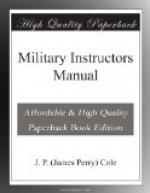These principles should not be neglected because they are simple. They can not be mastered without work, and unless they are mastered the voice will not be heard at a distance and will not last under the work of giving commands. Further suggestions on the manner of giving commands will be found under Physical Training.
CHAPTER 4.
Use of Modern Arms.
[Illustration: Plate #3]
Small Arms Firing.
Under this heading we have many phases of the training and exercises given to our armed forces. It has been found best to use simple every day methods to get the best results.
There are two principal factors—the rifle and the pistol. The former only will be taken up now. The scheme is to make the soldier a good shot singly and collectively, in time of peace and in time of war.
The course of instruction at this camp was arranged as follows:
(a) Nomenclature and care of the rifle. (b) Sighting drills. (c) Position and aiming drills. (d) Deflection and aiming drills. (e) Range practice. (f) Estimating distance drill. (g) Combat firing.
(a) Every man should be taught the names of the principal parts (see cut) of the rifle and how to clean and keep it clean.
(b) If time permits, the sighting bar described on page 26, s.a.f.m. should be used. To illustrate the normal and peep sight make a drawing on a blackboard of page 30, s.a.f.m.
Using a sand bag or some convenient rest for the rifle. The instructor sights it on some object showing the normal and peep sight. Using the above rests have a marker hold a disk against a large piece of paper towards which the rifle is pointed. There is a pin hole in the center of the bull’s eye on the disk. The range should be about 50 feet, and the bull’s eye about 1 inch in diameter. The marker moves it about until the man sighting tells him to “hold,” at which time he marks the center with the point of a pencil. This is done three times, the three points are then connected. The triangle thus formed is then used by the instructor to show the man whether he took too much or too little front sight or whether he leaned to one side or the other while aiming.
Use for this exercise both the normal and peep sight.
To show the effect of canting the piece use a sight setting of 1,000 yards, take out the bolt, aim the rifle while lying on a sand bag at a 1-inch bull’s eye 50 feet away. Then look through the bore of the rifle and have the place where the target would be approximately hit by a bullet marked. Cant the piece to the right and aim at the same bull’s eye. Then look through the bore of the rifle and mark the place where the bullet would approximately strike the target. The last mark would be lower and to the right of the first mark. It should be readily seen that in canting the piece to the right your sight is to the right of its original position—that is right windage. Also by canting it to the right your elevation is lowered, that is, lessened. Canting the piece to the left would make the bullet strike low and to the left.




